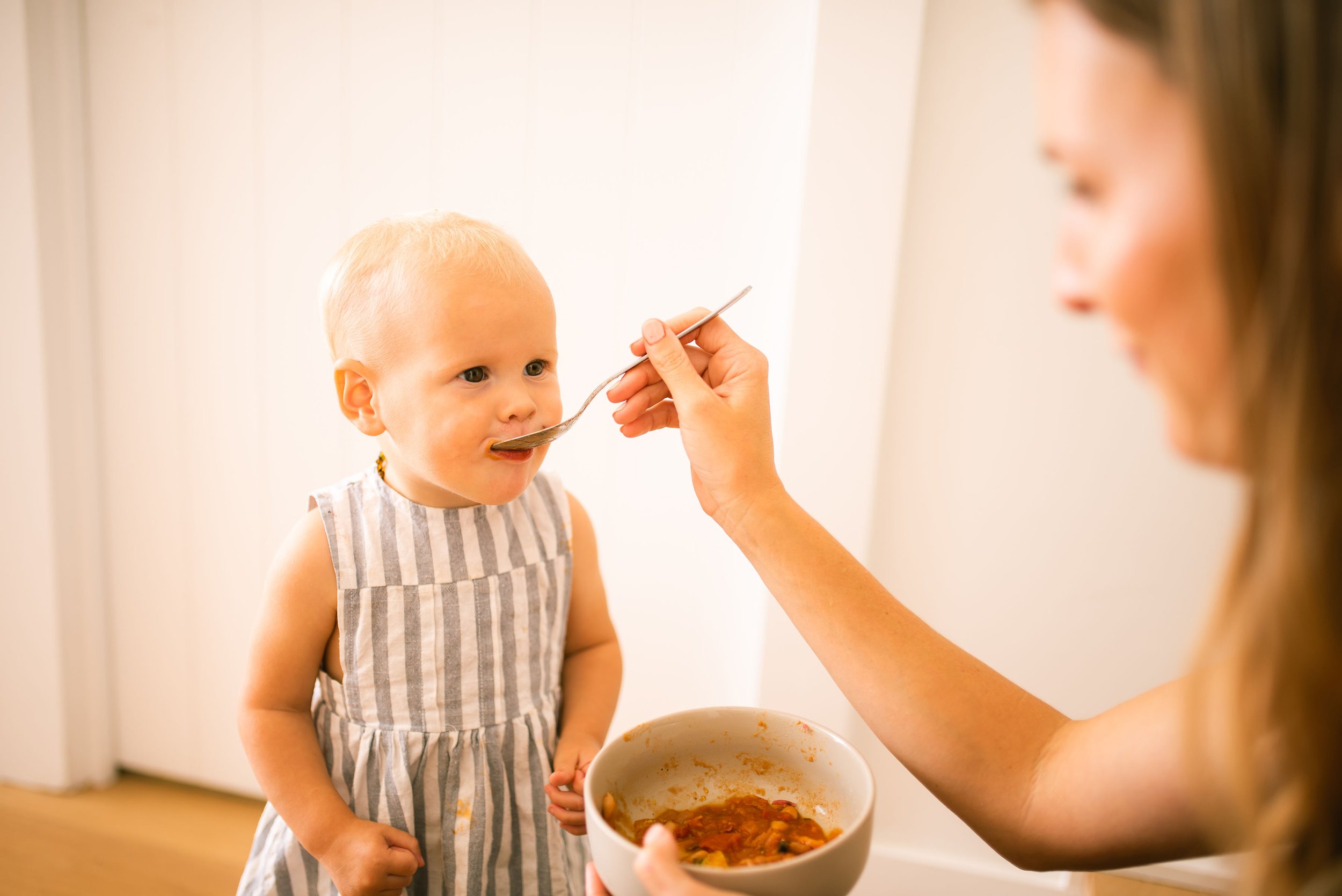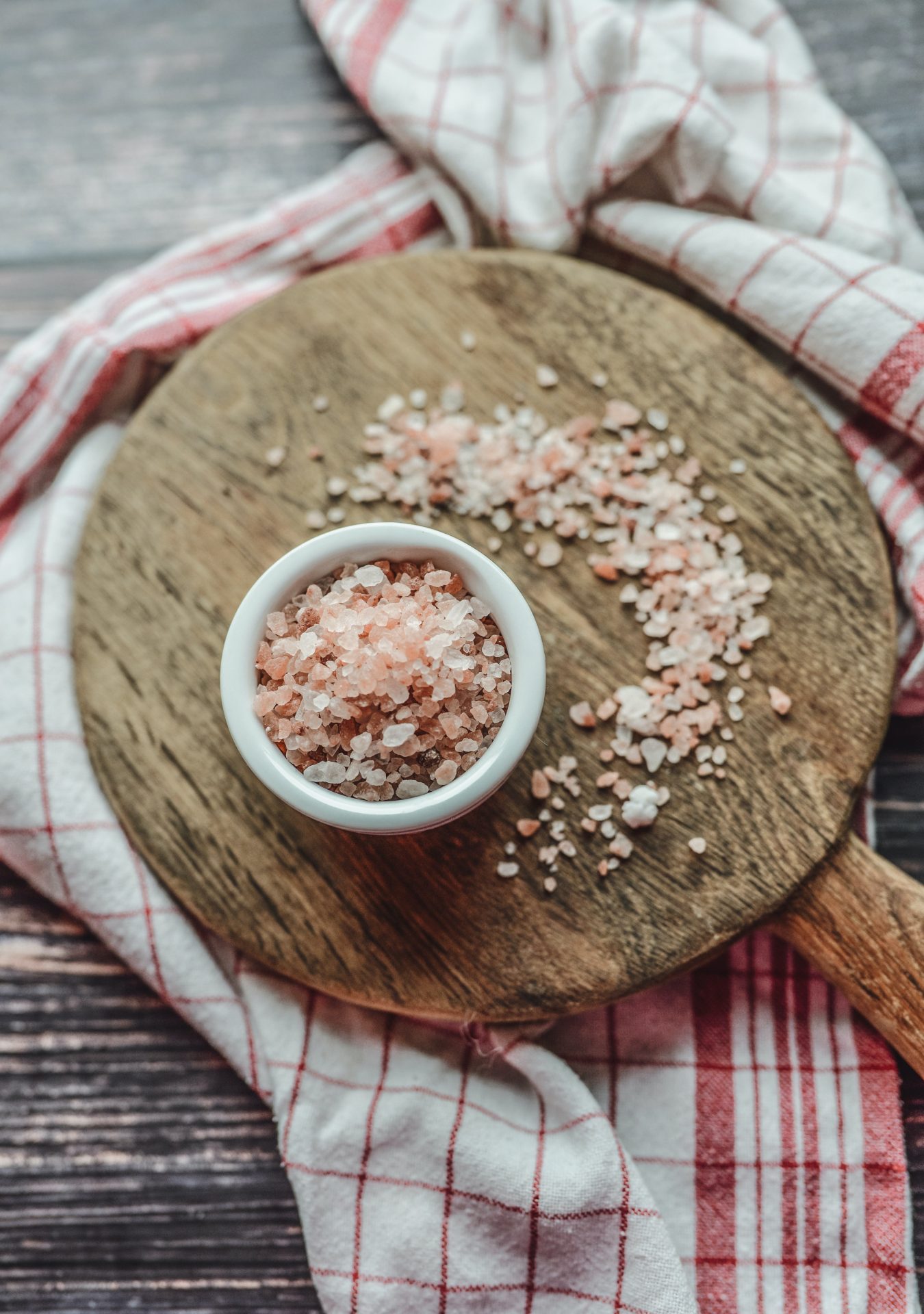Whether you are new to the baby-led weaning (BLW) journey or have been at it for a while, chances are you have some questions about safe food sizes and shapes. When it comes to preparing food for our babies, we’ve got a few priorities to juggle. We want to offer nourishing, nutrient-dense food, we want to reduce the risk of choking and we want to match foods to our little one’s fine motor, oral motor and gross motor skills to set them up for success. Let’s explore some guidelines and tips about safe food sizes, shapes and textures, as well as discuss the motor milestones that support these recommendations.

Note on skills needed for eating:
It is important to note that chewing skills do not automatically develop at specific ages. While there are age expectations for stages of chewing development, safe and coordinated chewing develops through practice, consistency and exposure to a variety of food shapes.1
Reducing choking risk:
While we cannot eliminate the risk of choking, there are certain things we can do to significantly reduce it. Waiting for signs of readiness before starting solids, creating a calm and posturally supportive eating environment, and maintaining parental confidence (easier said than done!) are some protective foundations.
Preparing food in an age-appropriate way and avoiding certain shapes and textures is also key to reducing choking risk. Round, firm, slippery and small are the riskiest shapes and textures that you want to avoid or modify for your baby. These textures and shapes of food are more likely to enter and lodge in the breathing tube, occlude the airway and can be harder to cough out. The good news is that most foods can be modified to make them safer. For round foods (like grapes and cherry tomatoes), if you can’t squish them (like a blueberry or chickpea), cutting them into quarters significantly reduces choking risk. Slippery foods like overripe banana or mango can be rolled in hemp seeds or desiccated coconut to add some texture. Additionally, remove any peel or rind from fruit and vegetables during the first few months and try to avoid very stringy or raw vegetables when getting started, such as raw green beans, celery, raw carrots etc.
Below is a list of foods that studies show pose the biggest choking risk 2,3:
- Sausages/hot dogs – quarter them lengthwise
- Whole nuts – crush or ground into a fine dust or offer as a nut butter
- Raw carrots – steam, boil, grate, puree or roast
- Lollies – avoid until molars are in
- Meat – offer slow cooked meat, shredded, ground, puree or large pieces to take bites from like lamb cutlets or chicken drumsticks
- Popcorn – avoid until age 5
- Fish with bones – remove bones
- Grapes – quarter
- Cherry tomatoes – quarter
- Raw apples – steam, boil, grate, puree or roast
- Fruit pips and stones – remove from the fruit before offering

6 months – 8 months
Size and shape guidelines:
We want babies’ first experiences with food to be safe and appropriately matched to their motor skills. This means offering large pieces! Contrary to what you may assume, when starting on your baby’s solid food journey, we want to focus on keeping food pieces big. Babies need to be able to grasp and hold onto their food. To avoid frustration for your baby, save the smaller pieces of food for a few months later when the pincer grasp is developed. Aim for food pieces that are the length of your index finger or long enough to stick out above your baby’s closed fist when they are holding on to it. For width, aim for around a two-finger width or bigger.4 Examples of appropriate foods include pieces of avocado, pan-fried liver strips and thickly cut roast vegetables.
Texture guidelines:
When preparing your baby’s first foods, there are a few textures we can offer. These texture recommendations are the same whether your baby has teeth or not. Keep in mind, gagging is a normal proactive mechanism and doesn’t mean you have prepared the food incorrectly!
- Soft: When preparing soft foods, check to see if they pass the squish test. Hold the food between your thumb and pointer finger and pinch. If the food softens easily this is safe to offer your baby. This means the food will be easily mashed and broken down between the baby’s tongue and the roof of their mouth.
- Hard munchables: Hard munchables are unbreakable foods that a baby can hold and chew, but won’t break off any pieces, like a “food teether”. These foods support chewing skills, help move the gag reflex further back in the mouth, and can feel nice on their little gums! Examples include corn on the cob with kernels removed, dried fruit stick, celery stick, etc.
Related motor milestones:
Around 6 months of age, typically developing babies will have reached milestones including bringing hands to midline, grasping and releasing in their palm, and bringing hands to mouth This is why we recommend starting with big pieces of food. Babies will have up-down and forward-backward tongue movements developing and will have integrated (or be close to integrating) their tongue thrust and bite reflex. They won’t have coordinated chewing skills yet, which is why it’s important to keep food either nice and soft or unbreakable.5,6
Closer to 8 months of age typically developing babies will be sitting without support, reaching, crossing their midline in play and may begin commando crawling. With this development in postural control and coordination, they will have increasing oral motor control including emerging munching skills and the ability to move food around their mouth. They will also start to show increasing fine motor skills. With these skills you might start to see your baby use their gums or their fingers to mash, tear or pull their large pieces of food into small pieces of food. Parents often wonder if this is safe. It is! If a baby is able to break their food into small pieces, it is very different and much safer than a caregiver placing small pieces of food in a baby’s mouth. When babies self-feed they look at and touch their food and the brain receives sensory and motor messages which prepare the mouth to either safely swallow, gag or spit the food out.7






9-12 Months
Related motor milestones:
Around 9 months your baby will start to develop their pincer grasp and the ability to smoothly release objects. This means they can use their index finger and thumb to pick up food and will be able to put these in their mouth. Once this skill is developed, it’s a sign your baby is close to being ready for ‘bite-sized’ pieces of food and very thin slices of firmer food. This is not the only relevant milestone. We also start to see emerging lateral movements of the tongue and jaw. This means babies begin to be able to move food side to side and around their mouth, which leads to more complex chewing.6
Size and shape guidelines:
With developing fine and oral motor skills, we can start to offer bite-sized pieces of food. Keep in mind that at this age a baby’s airway is the size of a drinking straw so we want to make sure the pieces are larger than this so that if the food is swallowed it won’t have the risk of blocking the airway. Around 1.5cm x 1.5cm is a good guide. It is more than appropriate to continue to offer large finger-shaped pieces of food as well, especially as you and your baby build confidence
Texture:
The safest foods to continue to offer and those that pass the thumb and finger squish test so they can be mashed by the tongue, the roof of the mouth and gums.
It is important to note that research indicates that regardless of how a baby starts solids, all babies should be introduced to some chewable finger foods by 9 months old. This is because there appears to be a critical window where introducing finger foods is essential to developing chewing skills and preventing picky eating from developing in the future.8






12-18 months
Relevant motor milestones:
With continued exposure to a variety of foods, a toddler will be developing their tongue and jaw skills which develops their chewing skills. Around 12 months we will see a toddler able to confidently transfer food from the centre of the tongue to both sides of the mouth, and around 15 months a toddler will have a well coordinated diagonal rotary chew. Between 12-18 months they are likely to develop the fine motor skills to bring preloaded spoons and forks to their mouth, but it is normal to continue to provide assistance with cutlery at this age.5,6
Size, shape and texture guidelines:
With these developments in a toddler’s chewing skills it is safe to follow your child’s lead and offer a variety of sizes, shapes and textures. Offer bite-sized pieces, big pieces, thin slices, grated foods and diced foods. Continue to safely prepare or avoid higher risk foods, as outlined above. Toddlers will usually spit foods out that they are unable to manage in their mouths.
18-24 months
Relevant milestones:
By this age, if your toddler has had consistent exposure and practice with a variety of food shapes and textures, their tongue and jaw movements should be able to coordinate a circular rotary chew.6 This is the same type of chewing we use as adults. This means the food can now easily move around the mouth in any direction and can be more safely broken down. Your toddler’s fine motor skills will likely be developing rapidly as well and by 24 months they may be able to load up their spoon and fork and bring them to mouth independently. (Continue to expect a little bit of mess!)
Size, shape and texture guidelines:
With these developments in a toddler’s chewing skills it is safe to offer a variety of sizes, shapes and textures while continuing to modify high risk foods as outlined above.






References:
1. Northstone, K., Emmett, P., Nethersole, F. (2008). The effect of age of introduction to lumpy solids on foods eaten and reported feeding difficulties at 6 and 15 months. _Journal of Human Nutrition and Dietetics, 12(_1), 43-54.
2. Centers for Disease Control and Prevention. Choking Hazards. February 2022, https://www.cdc.gov/nutrition/infantandtoddlernutrition/foods-and-drinks/choking-hazards.html, accessed 24/04/23.
3. Lorenzoni, G., Hochdorn, A., Beltrame Vriz, G., Francavilla, A., Valentini, R., Baldas, S., Cuestas, G., Rodriguez, H., Gulati, A., Sebastian van As, A.B., & Gregori, D. Regulatory and educational initiatives to prevent food choking injuries in children: An overview of the current approaches. Frontiers in Public Health, 2022, 10, Article 830876. https://doi.org/10.3389%2Ffpubh.2022.830876.
4. National Heath Service. Your Baby’s First Solid Foods. 2022 https://www.nhs.uk/conditions/baby/weaning-and-feeding/babys-first-solid-foods/ accessed 29/06/23.
5. Morris, S. & Klein, M. (2000). Pre-Feeding Skills: A comprehensive resource for mealtime development. Austin, TX: Pro-Ed.
6. Arvedson, J. (2006). Swallowing and feeding in infants and young children. GI Motility online, http://www.nature.com/gimo/contents/pt1/fig_tab/gimo17_T3.html
7. Shune, S. E., Moon, J. B., & Goodman, S. S. (2016). The Effects of Age and Preoral Sensorimotor Cues on Anticipatory Mouth Movement During Swallowing. Journal of Speech, Language, and Hearing Research, 59(2), 195–205.
8. Coulthard, H. & Harris, G. (2009). Delayed introduction of lumpy foods to children during the complementary feeding period affects child’s food acceptance and feeding at 7 years of age. Maternal & Child Nutrition, 5(1),75-85. doi: 10.1111/j.1740-8709.2008.00153.



+ show comments
- Hide Comments
add a comment